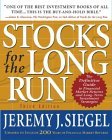Are GAO Projected Returns on Equities Reasonable?
In a recent study of the effect of the retirement of Baby Boomers on the price of equities, the GAO based its conclusions on the assumption that equities will provide real returns of over 7% over the next decades, stating:
 Implanting False Hope
|
||
“Returns on investment are important in helping many Americans accumulate sufficient savings throughout their working lives to meet their retirement needs. From 1946 to 2004, U.S. stocks have returned an average of 8.0 percent annually, adjusted for inflation.”
“According to a recent study surveying the literature, such simulation models suggest, on the whole, that U.S. baby boomers can expect to earn on their financial assets around half a percentage point less each year over their lifetime than the generation would have earned absent a baby boom.”
The GAO conclusions were dependent upon investors earning at least 7.5% per year on equity holdings, after inflation, for the foreseeable future.
Is this projection reasonable and is it based on fact?
And, why is this important?
Where Expectations of Market Returns Come From
The $14.9 trillion market value of US domestic equities (Q1 2006) is predicated upon common expectations of future returns on stock investments. The GAO figure of between 7 and 8% (real returns) is representative of current market consensus.
If this general expectation were to be significantly reduced, a loss of several trillion dollars of market value would almost inevitably follow. Holders of US equities would become much poorer should there be a substantial reduction in commonly projected long-term returns on equities.
A reduction in this widely-accepted projection would also impact heavily on defined-benefit pension funds and the savings plans of millions of households.
So how is it that millions of investors have come to believe that investing in stocks will produce long-term real returns of over 7% per year? After all, no one knows what the future holds.
How The Consensus Arose
How did the current consensus on projected stock returns come about?
- No common stock issuer that operates within the law promises specific returns to investors. Issuers leave precise figures to the investor’s imagination and avoid ‘forward looking statements’. Mutual funds display the disclaimer: “Past performance does not guarantee future results.”
- The largest portion of total returns used in these projections come not from the issuer, but from hoped-for sales to other investors at ever higher prices. How can anyone know what these ‘other investors’ will be doing ten or twenty years from now?
- Few individual investors or researchers, if any, have the time or inclination to collect, collate and analyze raw data on stock prices and dividends over many decades in order to arrive at an independent opinion about what average past returns on equities might have been.
- Most researchers and academics develop estimates of projected returns on equities by analyzing historic stock market indices published by companies like Standard and Poor’s and Dow Jones. These indices are commercial products designed to be marketable to Wall Street, which is interested mainly in short-term price fluctuations.
- Ordinary investors base their opinions on articles published by stock market promoters, academics, and financial writers. After reading similar projections in enough places, most accept such estimates as reliable, scientific, and even factual.
- Wall Street intermediaries spend a lot of money putting the historical performance of stocks in the most favorable light — implying that, despite disclaimers, past performance does indeed indicate future results.
In other words, the basis for common expectations of long-term returns on equities is past performance as suggested mainly by historical market indices and related statistics.
Standard & Poor’s stock index and dividend data are at the top of the list of indicators used for projecting equity returns.
Misinterpreting Stock Market Indices
If Standard and Poor’s stock index, adjusted for dividends, seems to suggest that investors earned an average real ‘return’ of 8% on stocks from 1946 to 2004, to most people it seems reasonable to project stock returns at a similar figure over the next decades.
But is it?
Questions we would want to answer when determining whether ‘past performance’ is a reasonable basis for projecting future stock returns for the average investor would be these:
“If investors were to select 100 stocks at random in each of the last one hundred years, holding these stocks and reinvesting dividends in the same portfolio, how much would this portfolio be worth after ten, twenty, and thirty years?”
“Using the same random portfolios as above, but valuing them at a fixed multiple of dividend yields compared to bond yields, with reinvestment at the same price basis, how much would these portfolios be worth after ten, twenty, and thirty years?”
This would give us an idea of past performance based on a buy-and-hold strategy for randomly selected portfolios over the long-term, and we would also be able to separate these ‘market return’ numbers from returns based on issuer performance — specifically dividends relative to the bond market.
Of course, we don’t have such numbers and must turn to the Standard and Poor’s index as a proxy.
A Gambler’s Biased Perception of Results
As Paul Newman, portraying Fast Eddie in the movie, “The Color of Money” said, “A dollar won is twice as sweet as a dollar earned.“,
Wall Street knows that it is good business to portray the stock market as more profitable than it really is and appeal to gambling instincts. Consequently, there are good business reasons why many professionals would want the S&P 500 index to suggest a rosy outlook for investment in equities.
 A Finger on the Wheel?
|
||
The problem with basing projected stock market returns on the Standard and Poor’s indices is that the index is biased towards stocks that are expected to do better, and that actually do better, than stocks randomly selected by ordinary investors.
In casino terms, the S&P 500 committee has its finger on the roulette wheel because of:
Biased Selection: The S&P500 indices are not based on randomly selected stocks. Instead, companies are chosen by the “S&P Index Committee”, based on what committee members deem to be “leading US companies from leading industries“, considering “the location of the company’s operations, corporate structure, accounting standards, the exchanges on which its shares are listed, and offices.” Furthermore, in selecting stocks for the index, the committee “regularly consults with the index-using community.” In short, the stock selection of the S&P500 index is biased towards what Wall Street institutions want, which obviously is not a random selection of cats and dogs, but rather stocks that market professionals think will perform best in the near future.
Market Capitalization Bias: The S&P500 indices are weighted according to market capitalization of the stocks selected for the index (recently modified to reflect that portion of shares that are publicly traded). This means that stocks like General Motors and Sears that were market favorites in the 1950s and that had fallen from grace by 2005, had a greater effect on annual total return, as measured by the index, in the year 1950 than in 2005. This inserts ‘best performance’ bias into the index.
Substitution Bias: When a company goes bankrupt or otherwise fails to meet the S&P committee selection criteria, it is removed from the index and substituted by another, more attractive stock. For example, Enron was included in the index until shortly before bankruptcy and then dumped to be substituted by a more worthy issue. Since new stocks included in the index are weighted by capitalization, the effect of substitution is to gloss over poor investments and start again. Real investors don’t have this option — they play with real money.
The result of this bias is to tilt the S&P 500 index towards suggesting more favorable returns on stock investment that are actually available on a random portfolio of stocks over the long-term.
Bias In, Bias Out
To illustrate the bias in the S&P index, suppose an investment trust had purchased 50 randomly selected stocks from the S&P index in 1900 and held these stocks in portfolio, reinvesting dividends in the same securities, over the next one hundred years.
By comparing the S&P stock index for 1900 with the index in 2000, one might innocently conclude that the investment trust should have performed extremely well over the century.
In fact, much of the trust money would have been lost because most of the companies in the 1900 portfolio would have gone out of business.
 Investor's Genie
|
||
In other words, in order to get results similar to the S&P index, the trust would have to have constantly changed the composition of its portfolio, selecting the leading stocks in the market every year. If a company in portfolio were to go bankrupt (as many obviously did over the century), a magic genie would have to step in and make the fund whole again.
It is no wonder that fund managers in the real world cannot outperform the S&P indices for long.
What is surprising, however, is that so many academics have been willing (and even eager) to accept the S&P index as an honest proxy for a randomly selected portfolio of stocks and, on this flawed assumption, conclude that fund managers are incompetent and that investors would be better off investing in ‘unmanaged’ index funds.
In order to accept the S&P index as a valid proxy for ‘average’ investment in stocks over the long-term, academics and Wall Street promoters must indulge in a not-so-subtle intellectual bait-and-switch maneuver:
They must consider a managed portfolio of carefully selected stocks of leading companies to be equivalent to a random, unmanaged portfolio.
In the real world, all stocks are owned by someone.
That means that the ‘cats and dogs’ of the investment world are just a much a part of the investment scene as are favorite stocks selected by the S&P Committee.
Since the number used for projected returns for investors in stocks over the next fifty years is supposed to represent reasonable expectations for average investors, many of whom will own stocks not blessed by the S&P Committee, it seems more than a little disingenuous to use the S&P 500 index as the basis for projecting long term returns on equities.
The ‘Unchanging Market’ Fallacy
Aside from problems in using the S&P index as a basis for projecting common stock returns, an even more serious error occurs with what we might call, the ‘Unchanging Market’ fallacy.
This is the tacit assumption that the stock market in 1920 was the same as the market in 1950, which in turn was the same as the market in 2005.
This is patently not true.
Since the largest portion of ‘total return’ as projected by the GAO represents capital gains, the causes of these price increases are relevant to our understanding of the future outlook for stocks.
For example, the market in the 1920s was driven by margin-based speculation. In the 1950s, prices were forced upwards by demand created by mass marketing of mutual funds. In the 1980s and 1990s, stock buybacks by corporations seeking to give value to executive stock options further drove prices upwards.
What will be the strong buying pressure that will drive stock prices even higher over the next fifty years, as the GAO predicts?
Although projections based on the S&P index suggest that from 1945 to 2000 stocks ‘returned’ an average of over 7% a year, we should note that in order to for these results to be achieved, the average price-earnings ratio of S&P stocks had to increase from ten to thirty.
Does this mean that the GAO thinks that average price-earnings ratios will continue to triple over then next half-century, say from thirty to ninety times earnings?
Since real GDP growth in the US has been running between 3% and 4%, and since it seems unlikely that stocks — on average — should perform better than the GDP over the long-term, without some ostensive outside force pushing prices higher than their intrinsic value, the GAO projected long-term real returns for equities of over 7% seems more than a little preposterous.
At least some external buying force that will drive prices upwards should be clearly identified.
Lamps Begin To Go On in Academia
There are signs that economics professors may be awakening to the problem of accepting stock market indices as a basis for projecting investment returns in the stock market.
Professor Jeremy Siegel of the Wharton School, until recently a leading advocate of investing in “Stocks For the Long Run”, and who had based his reasoning on historical ‘performance’ of stock market indices, has recently come out and sounded the alarm that dumping of stocks by Baby Boomers may drive down prices from 40-50%.
Forbes Magazine, on July 22, 2020, citing an article in the prestigious Financial Analyst’s Journal, reported:
Beware, say two finance experts in an alarming study recently published in the Financial Analysts Journal. They say that history-or at least the interpretation usually put on stock market history-is bunk. If they are right, the risk premium in coming decades won’t be anything like 5% and you shouldn’t count on the S&P 500 to provide you with a fat and comfortable retirement. …
The guys doing the study, Robert Arnott and Peter Bernstein, are not Ivory Tower theorists. Arnott manages $15 billion at First Quadrant L.P. in Pasadena, Calif. Bernstein is a New York-based economist who advises institutional investors. Neither expects S&P 500 index funds to do particularly well over the next several decades.
Quoting from the Arnott and Bernstein article, “What Risk Premium in ‘Normal’?“,
“…the long-term forward-looking risk premium is nowhere near the 5% of the past; indeed, it may well be near-zero today, perhaps even negative. Credible studies, in the US and overseas, are now challenging this flawed conventional view, in well-researched studies by Claus and Thomas [2001] and Fama and French [2000, Working Paper], to name just two. Similarly, the long-term forward-looking real return from stocks is nowhere near history’s 8%.”
“Our argument will show that, barring unprecedented economic growth or unprecedented growth in earnings as a percentage of the economy, real stock returns will probably be roughly 2-4%, similar to bonds. Indeed, even this low real return figure assumes that current near-record valuation levels are “fair,” and likely to remain this high in the years ahead. “Reversion to the mean” would push future real returns lower still.”
In a collection of academic papers presented to the Social Security Advisory Board in August 2001, entitled, “Estimating the Real Return on Stock over the Long Term“, Professor Peter Diamond of MIT estimated that for the market to achieve a 7% real return over the future, prices would first have to fall over 50%.
These academic articles will be read by few of the millions of unsophisticated investors that base their investment strategy on recommendations of Money Magazine and other promoters of optimistic projections of stock returns.
But unlike you, dear reader, who has had the patience to plow through this long article in an obscure corner of the blogging world, there are many innocent sheep are out there, unaware of the danger, waiting to be sheared when the next leg of the Crash of 2000 occurs.




























